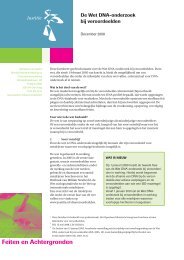INTERPOL HANDBOOK ON DNA DATA EXCHANGE AND PRACTICE
INTERPOL HANDBOOK ON DNA DATA EXCHANGE AND PRACTICE
INTERPOL HANDBOOK ON DNA DATA EXCHANGE AND PRACTICE
You also want an ePaper? Increase the reach of your titles
YUMPU automatically turns print PDFs into web optimized ePapers that Google loves.
Glossary1-24/7AlleleAmelogeninBiological evidenceBlood deviceBreathable bagCold hitContaminationControl sampleCrime scene stain<strong>DNA</strong><strong>DNA</strong> profile<strong>INTERPOL</strong>’s I-24/7 global police communications system connects lawenforcement officials in all of its 187 member countries, providing themwith the means to share crucial information on criminals and criminalactivities 24 hours a day, seven days a week.Alternative form of the same <strong>DNA</strong> section at a specific location (locus)on a chromosome. A single allele for each locus is inherited separatelyfrom each parent.The name of a gene which indicates the gender (i.e. sex) of the individual.Evidence derived from biological material, typically body fluidsassociated with serious crimes.Sterile devices (tubes, containers or other items) used for the recoveryof biological samples from individuals and crime scenes.Plastic or paper bag which allows moisture to pass through the bagthereby enabling damp/wet samples to dry out within the bag withoutdeteriorating/degrading.A match made in a database not based on investigative leads.The accidental pollution of a crime scene and/or sample with otherbiological or chemical substances. This may occur as a result of touching,sneezing, speaking over the crime stain/sample, and so forth.A standard against which other conditions can be compared. Forexample, an area adjacent to a crime stain to allow for problems withequipment to be detected.A biological sample that is found at the scene of a crime. <strong>DNA</strong> analysisis conducted to establish an association between the crime scene andan individual.Deoxyribonucleic Acid is a molecule found in most cells of all people,animals, plants and other organisms. Variations in the <strong>DNA</strong> sequenceenable the distinction between individuals.A set of <strong>DNA</strong> identification characteristics at numerous specific <strong>DNA</strong>locations (loci) that can be used to distinguish one person from thatof another person.PAGE 104Glossary







